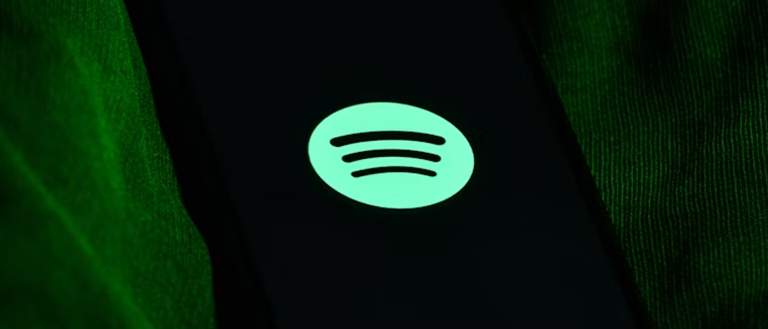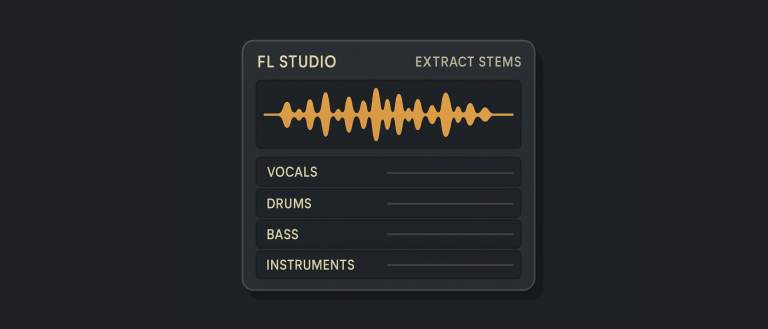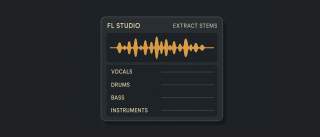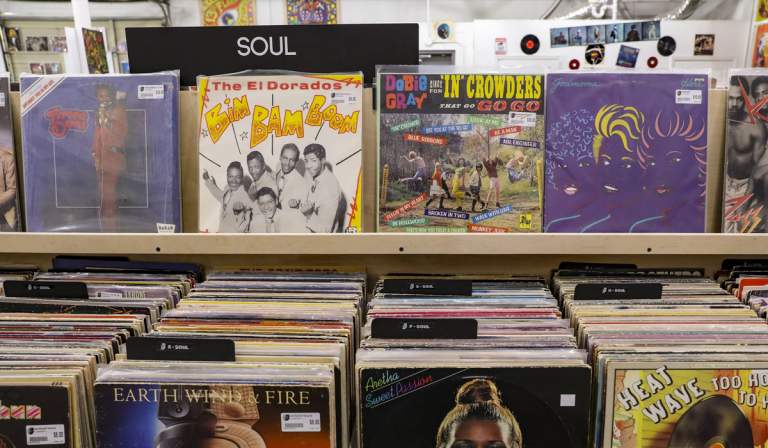AI has changed almost every creative field, and music is no different. AI-created songs have gone from basic tests to full songs that most listeners can’t tell apart from human-made ones. This change is affecting the music business in terms of creativity, tech, and money. But how does it all work?
But how does it actually work? How can a simple text prompt “powerful but calm music for long autumn evenings” turn into a complete instrumental song?
This article breaks down what’s happening behind the scenes, why AI music sounds so convincing, and what it means for producers, artists, and the future of music-making.
AI Music Industry Growth: How Fast the Market Is Expanding
The global market for AI-driven music tools was valued at $440 million in 2023. By 2030, it’s expected to explode to nearly $3 billion, with an annual growth rate of over 30%.
Right now, North America is really into it, but Europe and Asia are getting there fast. Stuff like Suno, one of the most widely used music generators – make up over 70% of the entire market.
And why is this happening? Simple. AI makes making music way cheaper and easier. Forget booking studios or hiring musicians – you can make a song that sounds pro without all that mess.
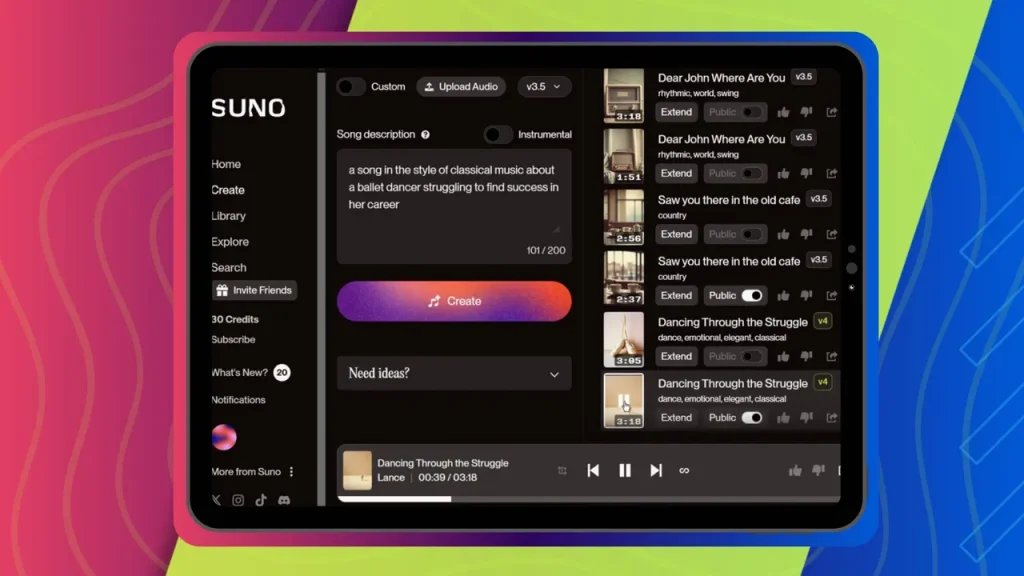
Why AI Music Sounds Human
Multiple streaming platforms have reported a fascinating trend:
Over 80% of listeners cannot reliably tell whether a track was created by an artist or by AI.
Modern AI systems have been trained on hundreds of thousands of hours of real music. They’ve learned:
- The structures of different genres
- How melodies change and grow
- How rhythms interact
- How o shape mood and dynamics
As a result, they mimic musical intuition with surprising accuracy.
This has sparked debate – ethical, economic, and legal, but it also shows how powerful these models have become.
How AI Actually Turns Text Into Music
A text prompt alone isn’t enough to create audio. Behind every AI-generated track is a multi-stage processing pipeline made of specialized models. Here’s a simple explanation of what happens.
1. Mulan: Getting What You Want from Sound and Text
The first model in the chain is Mulan, a “two-tower” architecture:
- One tower analyzes text prompts
- The other analyzes audio input (if you provide a reference track)
Its job is to convert your description into musical attributes such as:
- tempo
- mood
- style or genre
- intensity
- instrumentation
It’s like a translator that turns your words into musical ideas, similar to a musician who takes direction from a producer.
2. W2V-BERT: Building the Musical Blueprint
Okay, so the AI also needs a plan for how the song is put together. That’s where W2V-BERT helps out. It mixes:
- Wav2Vec (W2V) – understands audio patterns
- BERT – understands language and context bidirectionally
Together, they create semantic tokens: a compressed representation of how the track should be organized rhythmically and melodically. This is the “skeleton” of the final song.
3. SoundStream: Turning the Blueprint Into Real Audio
Finally, the structure is passed to SoundStream, the decoder model responsible for generating the actual sound waveform.
SoundStream takes the compressed musical outline and “decompresses” it into:
- full-resolution audio
- real instruments
- dynamics and expression
- stylistic details
This is where the magic happens. The music is, like, actually good now, sometimes just as good as if a person made it.
Why AI Music Sounds So Realistic
Once the process wraps up, you get a complete song – melodies, chords, rhythm, transitions, and even production stuff that’s ready to go. The AI totally nails the vibe you’re going for. Ask for something chill, and you get soft sounds. Want something energetic? It gives you hard-hitting drums. A lot of people can’t even tell it wasn’t made by actual musicians
This realism isn’t random. The AIs learn from tons of music – thousands of hours of professionally made songs from all kinds of genres and styles. It figures out how chords work, how instruments play together, how rhythms change, and how feelings turn into sound. By learning all this, it can make music that sounds normal, like it means something, and fits a style, even if no one plays an instrument.
AI Music Copyright. Who Owns It and Is It Legal?
AI music tech is pretty amazing, but the legal stuff is still a mess. The big question is: who owns a song made by AI? The AI makes the music, not a person, so the usual copyright rules don’t really work. Some places say only humans can own copyrights, but others are unclear, which makes things confusing for producers, labels, and streaming sites.
Putting AI music online is also a bit of a headache. You can upload it to streaming services, but each one has different rules, and most are still figuring things out. Some ask you to say if a song is AI-made. Others might make special sections for AI music or put limits on it as more songs get uploaded.
Something else to think about is whether AI music can even be copyrighted. A lot of lawyers say that if a human didn’t write it, it might not get copyright protection. So, artists could put out AI music but not be able to stop others from using it.
Then there’s the problem of AI music sounding too much like real artists. AI learns from real music and might accidentally make something similar, which could lead to copyright problems, even if it didn’t copy anything directly. It’s hard to say when something is just inspired by and when it’s a copy.
With up to 20,000 AI-generated songs uploaded daily to streaming services, legal frameworks still struggle to keep pace.
What Suno Says About Copyright and AI-Generated Music
Suno’s official stance is straightforward: you own the rights to the music you create with their platform, including commercial usage rights. However, they also make it clear that the material generated through AI may not qualify for traditional copyright protection in every country. In other words, you can legally use, publish, sell, and distribute the tracks you make in Suno, but the law may not always treat those tracks as standard copyrighted works.
Here’s What Suno Says About Copyright:
Here’s how creators can protect AI-generated music:
- Trademarks – No, you can’t trademark the song itself. But you can trademark your artist name, logo, and even your song title if it’s used as a recognizable brand element. This builds a public identity that nobody else can steal.
- Contracts & Licensing – Want to collaborate, distribute, or monetize? Use contracts. A well-written licensing agreement can define ownership, royalties, and rights—even if the music isn’t copyrightable. This is essential if you’re selling beats, scoring films, or collaborating with other artists.
- Access Rights – If you control distribution, you control the product. I use Patreon to release full-quality MP3s and early-access content. If you’re the only one with access to the stems, prompts, or mix files, you effectively own the music in practice.
- Trade Secrets – Got a custom AI workflow, prompt style, or sound aesthetic? Keep it confidential. That’s called a trade secret, and it’s legally protected as long as you don’t disclose it.
How Artists and Producers Can Actually Use AI
AI can already make good music, speed up creative work, and lower production costs. A lot of artists now use AI every day. They use it to write song ideas, try out different versions, check out different music types, fix up songs, or quickly make sample tracks before really working on them. Basically, AI is just another tool in the studio, like virtual instruments or mixing programs.
But, even now, AI doesn’t have the thing that makes real art: emotion. People don’t listen to artists just for their songs. They listen to them for who they are, what they’re like, and the feelings in their music. A machine can copy a style, but it can’t tell a story, share real life, or be close to fans.
That’s why the best producers will use AI to help, not replace. It can do easy tasks, create lots of ideas, and open up new creative options, but the artist still needs to guide it, give it meaning, and add feeling. The best part is when people and AI work together.
Human + AI: The Hybrid Future of Music Production
The future of music won’t be a battle between humans and AI, but a blend of both. AI already boosts creativity by generating ideas quickly, speeding up composition, and making experimentation more accessible to anyone with a computer. But the elements that define memorable music – identity, story, emotion, and authenticity remain uniquely human.
As AI becomes another standard tool in the creative process, the artists who thrive will be those who use it to extend their capabilities rather than replace them. The strongest work will come from this collaboration: human vision guided and amplified by intelligent tools.
In Conclusion
AI isn’t going to kill music; it’s just another tool that’s changing how songs are created, shared, and found. If artists and producers get how these systems work, they can use them on purpose, without being scared.
That way, AI can turn into a creative buddy instead of something that’s trying to steal your gig. This tech will keep getting better, and it’s only going to get more ingrained in the music biz. So, the best thing to do is jump in now: figure out how to slot AI into your process, keep your own style, and use these tools to make even better music than before.






